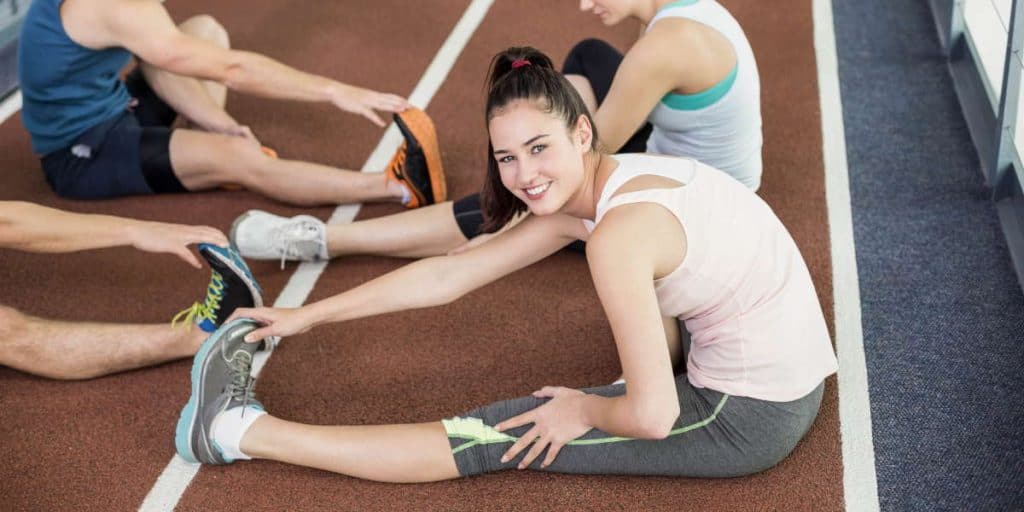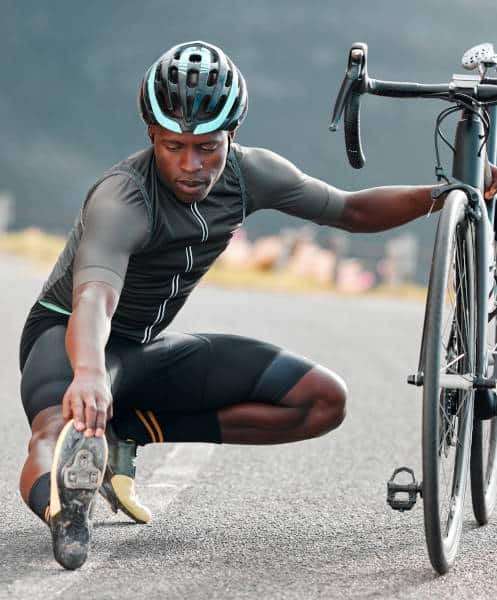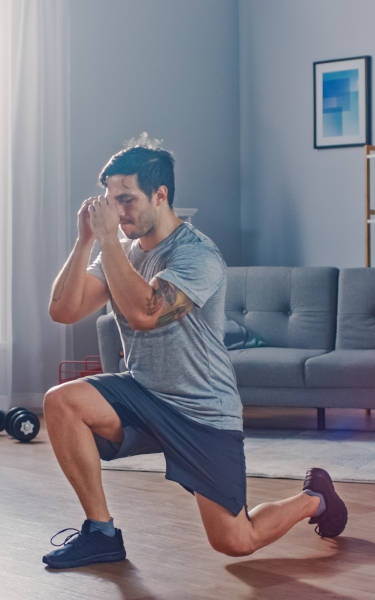How do I prevent foot and ankle injuries?
In the United States, 25,000 people sprain their ankle every day. One million Americans will visit the emergency room every year because of an ankle injury, with sprains and fractures being the most common complaints. Half of these sprains are the result of athletic activity.
Over 30% of injuries seen by sports medicine clinics are muscle injuries that can be prevented by warming up. Warm-up exercises are a critical part of sports injury prevention, especially if you’ve had a previous injury.
But it’s critically important to choose warm-up exercises that suit your current fitness level, align with the planned activity, and accommodate any existing injuries. For example, walking will be better than jumping rope if you’ve had a foot or ankle injury. But jumping rope can be ideal if you don’t have an injury, and plan to do a lot of jumping during your workout.
The human body holds the extraordinary potential to protect itself from musculoskeletal injuries. Warming up has proven to be the most effective way to use this potential. It prepares the body to handle repetitive and strenuous movements with resilience.

Why should I warm up before a workout?
A warm-up routine can be performed quickly and easily before engaging in strenuous physical activity. Before lacing up those sneakers and hitting the pavement, begin a warm-up routine with stretching to decrease the risk of injury. It’s an important step that will prepare both the mind and body for exercise.
Reasons to do warm-up exercises:
- It helps you find the mental motivation to exercise. It’s easier to convince yourself to do some simple stretches than it is to jump into a three-mile run. But once you’re up and moving, the momentum will help you follow through with your workout plans.
- Eases stiffness due to inactivity and cold weather. Stretching increases blood flow to the muscles, improves flexibility, and restores a full range of motion, decreasing the chance of injury.
Are there different types of warm-up exercises?
Yes, there are different types of warm-up exercises. Warm-ups can be active or passive. Many warm-up routines also include stretching, which can be dynamic or static.
Passive warm-up
In a passive warm-up, the body temperature increases due to an external source, such as a hot bath or sauna. This method achieves many of the same results as active warm-ups without causing fatigue. And it’s sometimes used to maintain body temperature between an active warm-up and an athletic performance.
Active warm-up
The most common warm-up exercises are active. An active warm-up improves the way the body uses oxygen without depleting energy stores. Experts advise following a general aerobic-type warm-up, with one that is more aligned to the activity you are about to perform.
Static stretches
Today, a brief static stretching routine can be used to loosen a joint. But experts suggest that stretching is more appropriate AFTER a workout, not before. Static stretching used to be part of most warm-up routines. It involved holding a position for 30 to 90 seconds. But researchers found that static stretching may hurt performance.

Dynamic stretches
Dynamic stretching involves moving the body in a way that mimics the upcoming activity. For example, runners often use walking lunges to warm up before a race. Swimmers are more likely to use shoulder rolls and arm circles. Body weight squats are a good warm-up for weightlifting.
In the British Journal of Sports Medicine, a systematic review was conducted to identify the impact of warm-up on performance and injury prevention. Strong evidence was found for the following: dynamic warm-ups enhance power and strength performance; warm-up swings with a standard-weight baseball bat are most effective for enhancing bat speed.
A proper warm-up routine can prevent hamstring strain, muscle strain, lower extremity injury, and any number of injuries in other muscle groups. Musculoskeletal injuries that result from overuse can also be prevented by warming up.
Do warm-up exercises improve or hurt athletic performance?
Most of the time, warm-up exercises improve performance. A review of several studies found that 79% reported improved performance after warmups. The percentage of improvement ranged from 1% to 20%. However, about 17% of the studies showed a decrease in performance.
Researchers also investigated why warm-ups might hurt performance. They found that warm-up routines were not effective when:
- The movement didn’t align with the upcoming activity.
- They were too short to be effective.
- They were too vigorous and depleted too much energy.
- Too much time passed between the warm-up and the activity.
Researchers also suggested that the runner’s age, level of conditioning, and psychological state could affect how effective a warmup is.
What foot and ankle stretches can I do for warm-ups?
Foot, calf, and ankle stretches can be used as warm-ups before any exercise program. Warm-ups may be recommended by podiatrists and physical therapists for treatment and recovery from plantar fasciitis, heel spurs, sprains, and related injuries.
Ankle and calf stretch
One way to stretch the ankle is in a seated position using a strap to pull the foot upward. This stretch targets the calf muscles, Achilles tendon, and plantar fascia found on the bottom of the foot. This is an effective warm-up before exercise, and it also helps prevent and treat painful plantar fasciitis.

Lunge
The lunge, or bent knee calf stretch, targets the soleus (calf) muscle. This stretch also targets the Achilles tendon and plantar fascia of the foot. The lunge is done on flat ground while leaning against a wall or other object for stability. Hold the stretch for at least 30 seconds on each side and repeat three to five times.
Toe stretch
The joints of the toes are subject to arthritis, soft tissue injury, and structural problems and can benefit from regular stretching. The toes can be flexed while squatting down or in a seated position, or while standing in a runner’s lunge.
Ankle stretch
Ankle warm-up exercises can be done before any workout, from strength training to running:
- Ankle pump-ups involve static stretching that improves the upward movement of the foot. Simply point your toes and foot upwards like you’re trying to touch them to the shin (dorsiflexion). Hold for 30 seconds and repeat five times on each side.
- Ankle pump downs involve pointing your toes and feet downward as far as you can. Hold for 30 seconds and repeat five times on each side. This stretches the calf muscles and increases ankle plantarflexion (downward movement of the foot). It also targets the ankle joint ligaments and tendons of the top of the foot.
How do I warm up for a run?
The best warm-up before a run consists of light cardiovascular exercise with stretching. Cardiovascular exercises are intended to increase circulation and increase heart rate. Stretching exercises help lubricate the joints by activating the surrounding soft tissue. The warm-up helps prevent injury caused by tight muscles.
Before a run, dynamic stretching will increase blood flow and loosen the muscles needed for running. Static stretching should be left until after a run before cooling down.
After intense exercise, lactic acid builds up in the muscles, and it takes time for the body to clear it. Cooling down exercises (such as stretches) can aid the process of releasing and removing lactic acid. This helps to speed up the body’s recovery post-workout and prevents muscle soreness.
The benefits of dynamic stretching are:
- Improved range of motion
- Improved coordination
- Warmed-up muscles
- Lubricated joints
- Improved blood flow
A well-planned warm-up lays the foundation for increased mobility and muscular coordination. It helps to gradually increase breathing and heart rate to a level that meets the demands of the planned exercise.
Running can sometimes cause foot problems. At University Foot & Ankle Institute we are here to keep your feet happy and your running smooth!
How can I prevent a sprained ankle or recurring sprain?
The following tips can help you prevent a sprained ankle or a recurring sprain:
- Warm up before exercising or playing sports.
- Be careful when walking, running, or working on uneven surfaces.
- Use an ankle support brace or tape on weak or previously injured ankles.
- Wear shoes that fit well and are made for the activity.
- Minimize wearing high-heeled shoes.
- Don’t play sports or participate in activities that you’re not conditioned for.
- Maintain good muscle strength and flexibility.
- Practice stability training, including balance exercises.
One of the great things about modern medicine is that there’s a doctor who’s well-versed in treating every part of the human body. And high-quality healthcare involves taking care of your ankles and feet.
So, when it comes to the often-neglected feet, it’s a foot and ankle specialist who will keep you active and healthy. That’s where University Foot & Ankle Institute comes in.
Why choose University Foot and Ankle Institute for your foot and ankle care?
Whether you need to find proper footwear, treat an injury, or get advice on proper foot care, we’re here to help. Our podiatrists offer the most advanced podiatry care and the highest success rates in the nation. We are nationally recognized foot and ankle specialists and leaders in researching, diagnosing, and treating all foot and ankle conditions and common injuries.
For a consultation please call (877) 736-6001 or make an appointment online now.
Our podiatrists take patients’ safety seriously. Our podiatry facility’s Covid-19 patient safety procedures exceed all the CDC’s coronavirus pandemic recommendations. Masks are always required in our institutes.
University Foot and Ankle Institute is conveniently located throughout Southern California and the Los Angeles area. Our foot doctors are available at locations in or near Santa Monica, Beverly Hills, West Los Angeles, Manhattan Beach, Northridge, Downtown Los Angeles, Westlake Village, Granada Hills, and Valencia.
References
Fradkin AJ, Gabbe BJ, Cameron PA. Does warming up prevent injury in sport? The evidence from randomised controlled trials?. J Sci Med Sport. 2006;9(3):214-220. doi:10.1016/j.jsams.2006.03.026
Petersen J, Holmich P: Evidence based prevention of hamstring injuries in sport. Br J Sports Med. 2005, 39: 319-323. 10.1136/bjsm.2005.018549.
- 15 Summer Foot Care Tips to Put Your Best Feet Forward - July 1, 2024
- If the Shoe Fits, Wear it… Especially for Kids Shoes! - September 4, 2023
- Is Barefoot Running Better? Or are you Running Toward Injury? - August 18, 2023